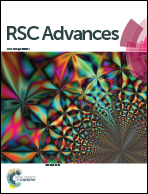Diffusion based kinetic selectivity modulation of enzymatic proteolysis in a microfluidic reactor: experimental analysis and stochastic modeling
Abstract
Microreactors enable new experimental ways for enzyme engineering. In this context, we show that the liquid–liquid parallel laminar flows in microchannels cause a kinetic selectivity modification of proteolytic enzymatic reaction involving hemoglobin and pepsin, reaction that generates numerous bioactive peptides at different advancement state. Here we show that this diffusion based kinetic modulation induces an altered peptides appearance kinetics for a part of the initial substrate population. Indeed, microfluidic and conventional batch experiments performed in the same reaction conditions lead to strong differences in the resulting peptidic profiles obtained by reversed-phase high-performance liquid chromatography. Such differences are explained by the laminar flow diffusive conditions inside microchannels and are supported by a stochastic algorithm based on the Michaelis–Menten equation. Several bioactive peptides are identified by mass spectrometry and show the potential of such methodology in peptides screening from a complex proteolysis but also for selective peptides preparation by microfluidics.


 Please wait while we load your content...
Please wait while we load your content...